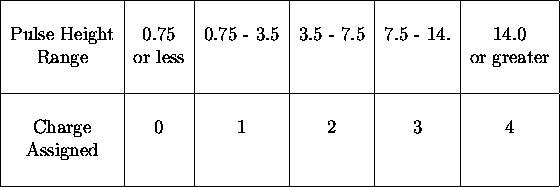First, a calibration process
was carried out to obtain slewing constants for the scintillator timing. Figure ![]() shows the mean time vs pulse height for one of the hodoscopes.
A polynomial is fitted to this distribution and used to correct the mean time.
shows the mean time vs pulse height for one of the hodoscopes.
A polynomial is fitted to this distribution and used to correct the mean time.
Figure: Mean time vs. pulse height (arbitrary units) from scintillation counter
simulation. The slewing which is clearly visible is corrected in the analysis.
The top and bottom photomultiplier times are used to calculate both the mean time and the
time difference, which gives the vertical position. The pulse heights are used for
the slewing correction and to calculate the geometric mean pulse height, which
is normalized to minimum ionizing (charge 1) and then used to assign a charge to
the particle causing the hit. The charges are assigned according to Table ![]() .
.

Table: Scintillator pulse height values used to assign charges in analyzing
Monte Carlo data. Pulse heights are normalized to charge 1.
Pattern recognition then begins with the hodoscopes since, as discussed above,
the hodoscopes provide a large amount of correlated information. For our
Monte Carlo studies we reconstructed every track passing the cuts described
below. In fact the only interesting tracks are those with velocities
considerably less than the speed of light ( ![]() 0.973). In the analysis of
data from the experiment we will impose time cuts on the hodoscope tracks
before trying to fully reconstruct tracks. Since on average there are less
than two tracks per event passing the ``late time'' cut, this will greatly
reduce the computing time required for pattern recognition.
0.973). In the analysis of
data from the experiment we will impose time cuts on the hodoscope tracks
before trying to fully reconstruct tracks. Since on average there are less
than two tracks per event passing the ``late time'' cut, this will greatly
reduce the computing time required for pattern recognition.
The pattern recognition proceeds by the following steps:
Figure ![]() shows the number of reconstructed tracks found in the
scintillator hodoscopes per event using the cuts described above.
Figure
shows the number of reconstructed tracks found in the
scintillator hodoscopes per event using the cuts described above.
Figure ![]() shows the number of tracks per event with confirming
hits found in the downstream straw tube arrays, and Fig.
shows the number of tracks per event with confirming
hits found in the downstream straw tube arrays, and Fig. ![]() shows the number of tracks per event with confirming hits in the upstream
straw tube array. The means are shown on each histogram. The similarity of
the means indicates that tracks found in the scintillators have a high
probability of being good tracks confirmed in the other detectors.
shows the number of tracks per event with confirming hits in the upstream
straw tube array. The means are shown on each histogram. The similarity of
the means indicates that tracks found in the scintillators have a high
probability of being good tracks confirmed in the other detectors.
Figure: Reconstructed tracks found in the scintillator hodoscopes per event.
Figure: Number of tracks per event with confirming hits found in the downstream straw tube
arrays.
Figure: Number of tracks per event with confirming hits in the upstream straw tube array.